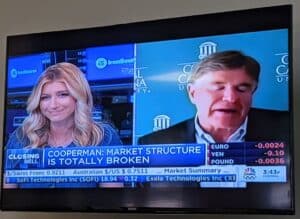Rustling Data

The Russell Reconstitution is so big everybody talks about it. And yet it’s not.
The Nasdaq touted its role facilitating this year’s Russell reset, saying, “A record 2.37 billion shares representing $80,898,531,612 were executed in the Closing Cross in 1.97 seconds across Nasdaq-listed securities.”
Impressive, no question. That’s a lot of stuff to happen in the equivalent of the proper following distance when driving 65 mph (a rule often ignored, I’ve observed).
I’d also note that the Closing Cross is not the “continuous auction market” required by SEC rules but a real auction where buyers meet sellers. Regulators permit these to open and close markets.
The Nasdaq said, “Russell reconstitution day is one of the year’s most highly anticipated and heaviest trading days in the U.S. equity market, as asset managers seek to reconfigure their portfolios to reflect the composition of Russell’s newly-reconstituted U.S. indexes.”
The press release said it was completed successfully and the newly reconstituted index would take effect “Monday, June 29, 2020.”
Somebody forgot to update the template.
But that’s not the point. What the Nasdaq said is untrue. The Russell rebalance June 25, 2021 was not “one of the heaviest trading days in the US equity market.”
It was 159th out of 252 trading days over the trailing year, using the S&P 500 ETF SPY as a proxy (we cross-checked the data with our internal volume averages for composite S&P 500 stocks, and against other major-measure ETF proxies).
SPY traded 58 million shares June 25 this year but has averaged over 72 million shares daily the trailing twelve months.
Whoa.
Right?
This is market structure. If a stock exchange doesn’t know, who are you counting on for facts about the stock market?

CNBC June 29, 2021
I snapped the photo here hurriedly of the conference-room TV at ModernIR yesterday with CNBC’s Sara Eisen and former TD Ameritrade Chair Joe Moglia. But look at what they call in video production the lower third, the caption.
That’s what hedge-fund legend Lee Cooperman said in the preceding segment. “Market Structure is totally broken.” Eisen and Moglia were talking about it.
When I vice-chaired the NIRI Annual Conference in 2019, I moderated the opening plenary session with Lee Cooperman, Joe Saluzzi, co-author of the book “Broken Markets” (you should read it), and Brett Redfearn, head of the SEC’s division of Trading and Markets (now head of capital markets for Coinbase).
The market may not appear broken to you. But you should know that market-structure events occur about 70 times per year. And the Nasdaq ought to know if the Russell Reconstitution is really a heavy trading day. It’s their business.
Just as it’s your business, investor-relations professionals, to know your market. The equity market.
Just the preceding week, June quad-witching owned the Russell Reconstitution like Mark Cavendish sprinting at the Tour de France. Worse, actually, though few cycling moments match seeing The Manx Missile win his 31st stage after having left the sport.
It was a beatdown. SPY volume June 16-18 averaged 97 million shares, 67% higher than the Russell rebalance, peaking the 18th at 119 million shares.
And June 30, 2020, the final trading day of the second calendar quarter last year, SPY traded more than 113 million shares, nearly twice this year’s Russell volumes June 25.
June 30 is today.
In fact, the last trading day of each month in the trailing twelve averaged 99 million shares of SPY traded.
What do those dates and June 16-18 have in common? Derivatives. Each month, there are six big expirations days: The VIX, morning index options, triple- or quad-witching, new options, the true-up day for banks afterward, and last-day futures.
This final one is the ultimate trading day each month featuring the lapsing of a futures contract used to true up index-tracking. The CBOE created it in 2014 for that purpose. Russell resets may be using it instead.
What’s it say that derivatives expirations are 67% more meaningful to volume than an annual index reconstitution for $10 trillion pegged dollars, or that average daily volume in SPY, the world’s largest exchange-traded derivative – all ETFs are derivatives, substitutes for underlying assets – exceeds volume on a rebalance day?
That your executive teams and boards better know. They deserve to know. If you give them anachronistic data unreflective of facts, it’s no help. Imagine if Lee Cooperman is right, and our profession fails our boards and executive teams.
No practice has a higher duty to understand the equity market than the investor-relations profession. If you’re not certain, ask us for help. We’ll arm you so you need never worry again about fulfilling it.
The post Rustling Data appeared first on ModernIR.
